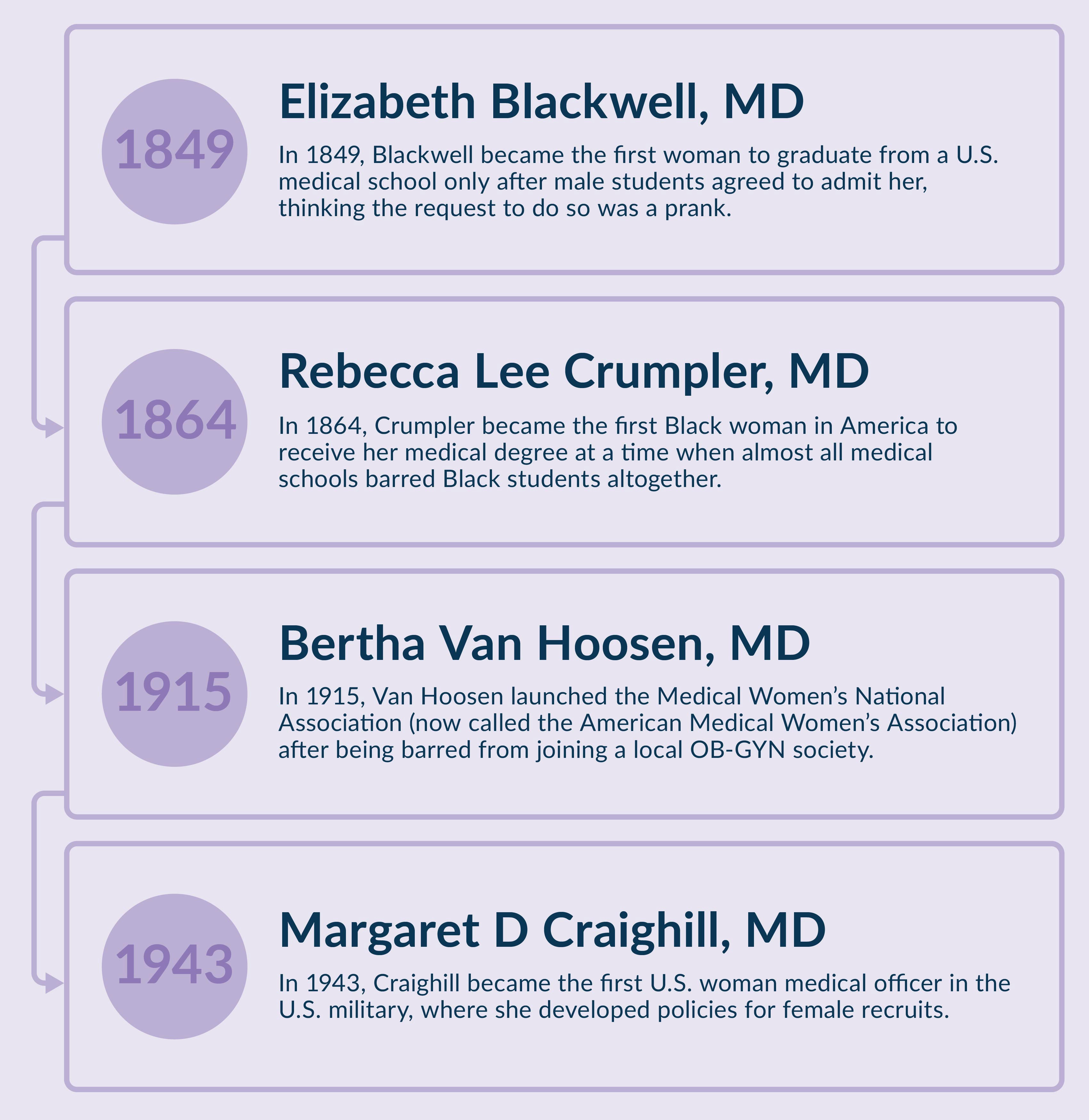Women’s History Month: Celebrating Women in Healthcare

As a provider of healthcare training programs, Nasium Training celebrates women in healthcare, honoring their past, present, and future contributions.
While women make up less than half of our nation’s labor force,1 they hold nearly 80% of healthcare positions.2 This makes Women’s History Month the perfect time to pay homage to all the fierce, yet caring female healthcare professionals who work (and have worked) so tirelessly to advance the industry, also advancing other women within it.
Let’s take a stroll into the past, highlighting a few women who arguably changed the healthcare landscape. We’ll dive into where women are in this field today (spoiler alert: they are significantly underrepresented in leadership) and end with several strategies organizations can put into place to support their female team members.
Influential Women in Healthcare’s History
Several women have left their mark on the healthcare industry in past centuries, despite facing major challenges during their time. The Association of American Medical Colleges shares several, some of whom include:3

Other notable women have contributed greatly to the healthcare field. Florence Nightingale (the founder of modern nursing), Clara Barton (founder of the American Red Cross), and Dorothea Dix (an advocate for people with psychiatric disabilities)4 are a few to consider, along with countless others whose contributions are just as powerful, even if not as well-known.
There’s no denying representation of women in the healthcare space has come a long way from where it was years ago. Still, there’s room for improvement to dismantle barriers pitched against women — especially concerning women in roles of leadership.
Barriers to Women in Healthcare Leadership
Women may be a majority in the healthcare workforce, but they are the minority in decision-making positions, holding only 25% of healthcare leadership roles.5 This reduces their ability to share transformational input on organizational and systemic issues, including those that affect their own health.

What barriers do women in healthcare face when attempting to rise to the top of their departments, organizations, or even the industry?
Gender Stereotyping
Some view healthcare positions as female roles. Women who work in healthcare often feel a need to always be available, to perform tasks assigned to other team members, and to be nice to coworkers in order to gain their cooperation.7 This adds time and energy stressors not experienced by their male counterparts.
Discrimination
When we talk about diversity in the healthcare workforce, race is often the first demographic to come to mind. But female healthcare workers can also face discrimination because of their gender. They may be bypassed for promotions even when equally as qualified, for example, or earn less than males in the same role.

Workplace Violence
A global study of healthcare workers found that women in the workforce experience verbal abuse, sexual harassment, and bullying more often than men.9 This type of behavior can discourage women from pursuing, entering, or retaining leadership roles.
Family Obligations
If a female healthcare worker is trying to raise children or take care of sick parents, in addition to handling all their other obligations, it can be difficult to find the additional time needed to put into an executive healthcare position. Their professional career goals may be set aside to care for the ones they love.
Lack of Mentorship
Having a mentor gives a new or growth-minded professional someone to ask questions to and seek guidance from. They can gain knowledge from the mentor’s experiences, providing them with access to years of wisdom. Fewer professional women in healthcare means fewer available mentors for those aspiring to enter these roles.
Self-Doubt
Research reveals that women are less likely to apply for more advanced, higher-paying positions because they don’t feel qualified enough, especially if they don’t meet every job requirement (unlike men, who typically apply even if they lack some of the qualifications).10 Their self-doubt closes the door on advancement opportunities before it even has the chance to open.
How We Benefit from Women Executives in Healthcare

Women bring unique experiences and perspectives to the table when making decisions about processes, procedures, and healthcare in general. They come with different ideas and viewpoints about what is broken, as well as how to fix it.
Women in management positions also have higher levels of engagement than men in managerial roles — by eight percentage points.12 When healthcare workers are engaged, it can improve retention rates, increase morale, and even financially impact an organization’s bottom line.13

Another benefit of female managers is that they’re better at building a good rapport with mixed-gender teams, contributing to increased productivity and higher sales.15 This makes them an important part of a strong healthcare team.
Breaking Down the Barriers for Professional Women in Healthcare
Organizations can make it easier for women to pursue leadership roles by reducing the barriers that exist. Create a workplace environment that dispels gender stereotypes and develop a zero policy for discrimination and workplace violence. Additionally, consider providing female team members access to resources that can assist with family obligations, such as childcare or eldercare benefits, also giving them access to mentors who can help alleviate their self-doubt.
Actions such as these can create an environment where women feel empowered to take the next steps in their healthcare career. It tells them that you’re committed to ensuring they have the tools they need to succeed; that you support their growth and development, which includes preparing them for leadership roles.

Nasium Training’s healthcare training programs can be a valuable part of this support. We provide healthcare professionals with the knowledge and skills needed to excel in their chosen roles. Some of our training programs also prepare professionals to sit for certification exams, giving them additional qualifications to pursue roles with these advanced requirements.
Contact us today to learn more about our training solutions and how they can be customized to meet your healthcare workforce needs.
1 Bureau of Labor Statistics. Employment Projections. Civilian labor force, by age, sex, race, and ethnicity. https://www.bls.gov/emp/tables/civilian-labor-force-summary.htm
2 Centers for Disease Control and Prevention. National Institute for Occupational Safety and Health (NIOSH). About Healthcare Workers. https://www.cdc.gov/niosh/healthcare/about/index.html
3 Weiner S. A brief timeline of women in medicine. AAMC. https://www.aamc.org/news/brief-timeline-women-medicine
4 SKCTC Library. Research Guides: Nursing. https://southeast.kctc.libguides.com/nursing/history
5 Grande D. Breaking barriers: Advancing gender equality in healthcare leadership. Chief Healthcare Executive. https://www.chiefhealthcareexecutive.com/view/breaking-barriers-advancing-gender-equality-in-healthcare-leadership-viewpoint
6 Healthcare Businesswomen’s Association. When Women in Healthcare Struggle with Their Own Health, The Healthcare Sector Suffers: Global Survey from Healthcare Businesswomen’s Association and FemTechnology. https://hbanet.org/news/2025/01/21/when-women-healthcare-struggle-their-own-health-healthcare-sector-suffers-global
7 Temkin SM, et al. “Women’s work”: Gender and the physician workforce. Soc Sci Med. https://www.sciencedirect.com/science/article/pii/S0277953623009139
8 National Partnership for Women & Families. America’s Women and the Wage Gap. https://nationalpartnership.org/wp-content/uploads/2023/02/americas-women-and-the-wage-gap.pdf
9 Nelson S, et al. A gender-based review of workplace violence amongst the global health workforce—A scoping review of the literature. PLoS Global Public Health. https://journals.plos.org/globalpublichealth/article?id=10.1371/journal.pgph.0003336%20
10 Baskin K. Breaking Through the Self-Doubt That Keeps Talented Women from Leading. Harvard Business School. https://www.library.hbs.edu/working-knowledge/breaking-through-the-self-doubt-that-keeps-talented-women-from-leading
11 Al-Arshani S. Business Insider. https://www.businessinsider.com/ruth-bader-ginsburgs-memorable-quotes-throughout-her-life-and-career-2020-9
12 Frumar C, Truscott-Smith A. Women’s Engagement Advantage Disappears in Leadership Roles. Gallup. https://www.gallup.com/workplace/646748/women-engagement-advantage-disappears-leadership-roles.aspx
13 Dudley J. Employee engagement in 2024: Trends, challenges and opportunities. Press Ganey. https://info.pressganey.com/press-ganey-blog-healthcare-experience-insights/employee-engagement-in-2024-trends
14 Southwick R. Healthcare worker engagement is rising, but high turnover persists. Chief Healthcare Executive. https://www.chiefhealthcareexecutive.com/view/healthcare-worker-engagement-is-rising-but-high-turnover-persists
15 Baskin K. Rapport: The Hidden Advantage That Women Managers Bring to Teams. Harvard Business School. https://www.library.hbs.edu/working-knowledge/rapport-the-hidden-advantage-that-women-managers-bring-to-teams
